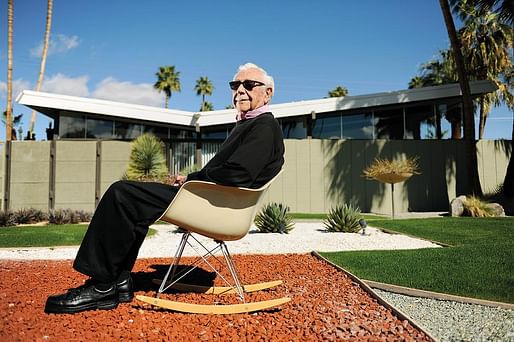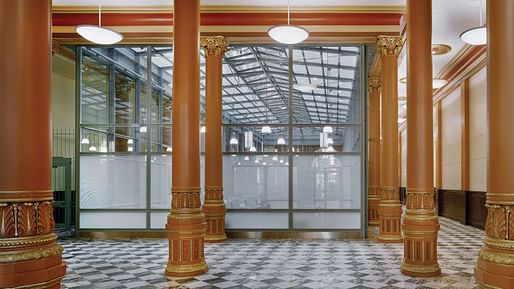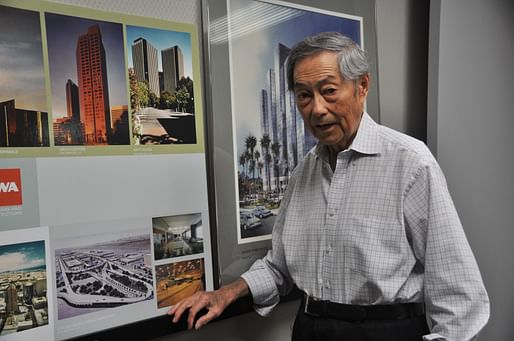
In 2017, we said farewell to some of our most legendary names. This year will regretfully be remembered for its notable losses as we said goodbye to some of architecture's biggest and brightest champions, educators, historians, and practitioners. Here, we pay tribute to those who changed the field, and for many, our lives.
Carter Manny (1918-2017)
Over the course of his decades-long career, Carter Manny, who passed away at 98 earlier this year, worked on iconic projects such as the O'Hare International Airport and the J. Edgar Hoover F.B.I Building. He also served a lengthy career as the director of the Graham Foundation, a Chicago organization that offers research grants to architects around the world.
Hugh Hardy (1932-2017)
Over the course of his legendary career, architect Hugh Hardy breathed new life into some of New York City’s most famous theatrical landmarks, with his many restoration and renovation projects including Radio City Music Hall, the New Amsterdam Theater, and the Rainbow Room among others. Hardy passed away in March while attending a dance performance at the Joyce Theater—an former crumbling movie house that he had renovated 30 years prior and turned into one of the premiere dance theaters in the world. He will be remembered for his overall influence on the architecture profession, the historic preservation movement, and urbanism in New York.
Vito Acconci (1940-2017)
The pioneering conceptual artist and experimental architect, who had been a deeply influential force on the New York art scene for decades, died in April of 2017. By the 80s, the poet-turned-performance artist founded Acconci studio and began to focus on theoretical design and building as well as landscape architecture. Among his most notable projects are Murinsel, a floating platform on the Mur river in Austria, and Walkways Through the Wall, an installation in the Midwest Airlines Center in Milwaukee. But for architects, Acconci's most recognizable work will be his collaboration with Steven Holl, the Storefront for Art and Architecture in New York.
Diane Lewis (1951-2017)
Lewis, who died in May, was a central fixture in the New York architecture community as a theorist, historian, practitioner and teacher. After working for Richard Meier, I.M. Pei and then establishing her own eponymous firm, the decorated architect and beloved educator became the first woman appointed to The Cooper Union's full-time architecture faculty, where she was tenured in 1993. She fiercely dedicated her practice to studio teaching and critical writing, inspiring many students with an approach that encouraged an engagement with concepts of “the architecture of the city.”

William Krisel (1924-2017)
William Krisel, a pioneering architect who brought his vision of mid-century modernism to Southern California tract housing, died this year at the age 92. The esteemed architect, known for his use of the butterfly roof, worked largely in Southern California having designed over 30,000 homes in the region. His legacy continues to capture the public’s imagination fostering a significant preservation movement and placing many Krisel-designed homes on the market.

Robert Michael Kliment (1933-2017)
Robert Michael Kliment, who passed away in June, was a cofounder of the New York-based practice, Kliment Halsband Architects. Prominent works on which he was the principal designer include the computer science buildings at Princeton and Columbia, the renovation of the Yale Divinity School, and federal courthouses in Brooklyn, New York, and Gulfport, Mississippi. He practiced a humanistic architecture that engaged thoughtfully with historical and cultural contexts and as a practitioner, he brought a rigorous precision to the everyday craft of design.
Frank Welch (1927-2017)
Known affectionately as "The Dean," Frank Welch's 90 years on earth spanned the creation of numerous spacious, elegant structures in a state primed for the appreciation of wide open spaces. Welch was the standard bearer of Texas regional modern architecture with some of his most famous works including "The Birthday," the Walter Davis House, and the Forrest Oil Building in Midland. He passed away in June of this year.
Peter Pran (1935-2017)
The Norwegian-born architect Peter Pran died on July 5 at the age of 81, following decades at firms such as Ellerbe Becket, Skidmore, Owings & Merrill, and NBBJ, where he built a reputation for championing innovation in large practices. Pran was also an influential educator, having taught at schools including the University of Kansas, Cornell University, and the University of Illinois-Chicago, as well as schools in Japan, Italy, and Denmark.
John Macsai (1926-2017)
The Hungarian-born architect and Holocaust survivor John Macsai, who passed away in August, left his mark on Chicago with his numerous high-rises along Lake Shore Drive and the famed Purple Hotel; now demolished, the Hyatt property hosted everyone from Michael Jordan to Perry Como back in its heyday.
Gunnar Birkerts (1925-2017)
The Latvian-born architect known for his unexpected forms passed away this year at the age of 92. After moving to the U.S. in '49 and working for Eero Saarinen, Birkerts went on to establish himself as a leading practitioner of the high Modernist style with projects such as the Contemporary Arts Museum in Houston and the Federal Reserve Bank in Minneapolis. Shortly before his passing, the AIA awarded him with their Library Building Award for his final, and perhaps most triumphant building, the Latvian National Library in Riga.
Fred Koetter (1938-2017)
Founding principal of the Boston-based practice Koetter Kim & Associates, Fred Koetter passed away in August at the age of 79, leaving behind an extensive architectural legacy. The architect, teacher, urbanist, and former Dean of Yale School of Architecture, was a dedicated fan of downtowns and oversaw the creation of urban projects such as Miller Park Plaza in Chattanooga, Tennessee; the Codex Corporation headquarters in Canton, Massachusetts; and the Firestone Library at Princeton University during the course of his career.

Gin Wong (1922-2017)
Gin Wong was one of a unique group of Chinese-American architects who helped define the postwar architecture of Los Angeles. The influential, though often overlooked, modernist is responsible for some of the city's most iconic buildings; he is credited with the spider-like structure of the Theme Building at LAX, had a principal role in creating CBS Television City, his Union 76 station in Beverly Hills remains as one of the highest examples of Googie architecture in the world, and he even inspired the designers of the legendary 1962 animated TV show, The Jetsons.
David Marks (1952-2017)
Marks, who had been suffering a long battle with cancer, passed away back in October at the age of 64. The Jewish architect was famed as the innovative visionary behind fanciful projects like the London Eye and the British Airways i360 observation tower. After founding his practice, Marks Barfield Architects, with his wife Julia, the two became known for their entrepreneurial spirit and determination (they often invested in their own projects) to see their ambitions through.
Albert C. Ledner (1924-2017)
An apprentice to Frank Lloyd Wright, Albert C Ledner was catapulted onto the national stage for a trio of buildings he designed for the National Maritime Union. Known for his whimsical spirit that led to joyous flourishes like using ashtrays along rooflines, Ledner also had a prolific career designing more than 40 residences in the New Orleans area. His daughter, Catherine Ledner, released a film about her father last summer, fueling a renewed interest in his work before his passing in November.

Vincent Scully (1920-2017)
After a 60-year-long teaching career at Yale University, the architecture historian Vincent Scully passed away earlier this month due to complications of Parkinson's disease. Known for his inspired lectures and humanistic proverbs, Scully has deeply shaped the field with his teachings and influenced generations of students—including Norman Foster, Robert Stern, Maya Lin and Paul Goldberger to name a small few.
MacDonald Becket (1928-2017)
The former board chairman and CEO of the influential California firm Welton Becket and Associates passed away at the age of 89. Taking over the firm for his uncle—who designed LA icons like the Capitol Records Building and Cinerama Dome—in 1969, Becket was instrumental in coordinating the master planning and architectural implementations of the 260-acre Century City project, and in the successful renovation of the state capitol building in Sacramento. He also designed the personal homes of former US presidents Dwight Eisenhower and Gerald Ford, attesting to his far reaching influence.
Beverley Thorne (1924-2017)
The California architect and last living contributor of the Case Study Houses program passed away recently at the age of 93. His contribution, the Harrison House or #26, was a four-bedroom, all-white steel frame home perched on top a hill in the Bay Area. Thorne was also the architect behind the often photographed California and Connecticut homes of the legendary jazz pianist Dave Brubeck.
Find more 2017 in Review wrap-ups here.
2 Comments
Unfortunately we have a last minute addition... Architect & Developer John Portman.
I would add the architectural historian Gavin Stamp.
Block this user
Are you sure you want to block this user and hide all related comments throughout the site?
Archinect
This is your first comment on Archinect. Your comment will be visible once approved.